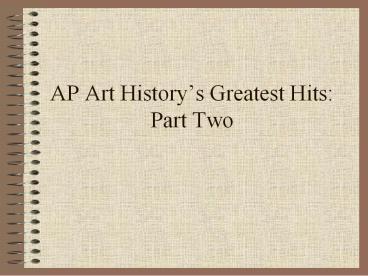AP Art History - PowerPoint PPT Presentation
1 / 28
Title:
AP Art History
Description:
AP Art History s Greatest Hits: Part Two Late Gothic Arnolfini and His Bride by Jan Van Eyck 1434 Characteristics: Almost every object portrayed sanctity Symbolism ... – PowerPoint PPT presentation
Number of Views:274
Avg rating:3.0/5.0
Title: AP Art History
1
AP Art Historys Greatest HitsPart Two
2
Late Gothic
- Arnolfini and His Bride by Jan Van Eyck
- 1434
- Characteristics
- Almost every object portrayed sanctity
- Symbolism
- Purpose Record and sanctify marriage
- Dog Fidelity, Shoe Holy Ground
3
Baroque in Italy
- Calling of Saint Matthew by Caravaggio
- 1597-1601
- Characteristics
- Jesus arm reminiscent of Michelangelo
- Piercing ray of light
- Realist and dramatic
4
Baroque in Spain
- Las Meninas by Velázquez
- 1656
- Characteristics
- Painter represented himself
- Visual and narrative complexity
- Represented form and shadow
- Tonal graduations dark to light
5
Baroque in Flanders/Holland
- The Anatomy Lesson of Dr. Tulp by Rembrandt Van
Rijn - 1632
- Characteristics
- Evenly placed subjects
- Corpse Diagonally placed and foreshortened
- Student poses and expressions show personality
6
Rococo
- The Swing by Frangonard
- 1766
- Characteristics
- Intrigue picture
- Landscape setting is out of Watteau
- Glowing pastel colors and soft light
- Convey the scenes sensuality
7
Neoclassicism
- Oath of the Horatii by David
- 1784
- Characteristics
- Conflicts between heart and patriotism
- Statuesque figures- men Rigid, Angular
8
Romanticism
- Raft of the Medusa by Gericault
- 1818-1819
- Characteristics
- Actual historical event
- Subdued palette and prominent shadow lend ominous
pall to the scene - Emotionally charged
- Comments on slavery? Apathy
9
Realism
- Le Dejeuner Sur LHerbe by Manet
- 1863
- Characteristics
- Figures in soft focus
- Broadly painted the landscape
- Black is a prominent color
- Allusions to many paintings of genres
10
Impressionism
- Ballet Rehearsal by Degas
- 1874
- Characteristics
- Figures randomly placed, not centered
- Degas was interested in reproducing single moments
11
Post Impressionism
- Starry Night by Van Gough
- 1889
- Characteristics
- Communicated the vastness of the universe
- Uses color to express himself
- With the turbulent brush strokes, the color
suggests a quiet but persuasive depiction
12
Symbolism
- The Cry (Scream) by Munch
- 1893
- Characteristics
- Grounded in the real world
- Departs significantly from a visual reality
13
Art Nouveau
- Casa Milá by Gaudi
- 1907
- Characteristics
- Free-form mass
- Organic lines not geometric
14
Fauvism
- Red Room by Matisse
- 1908-1909
- Characteristics
- Color Warmth
- Colors contrast richly and intensely
- Depicts objects in simplified and schematized
fashion and flattening out form
15
German Expressionism
- Fate of the Animals by Marc
- 1913
- Characteristics
- Entire scene is distorted- Shattered into
fragments - Colors of severity and brutality of wars anguish
and tragedy
16
Dada
- Unique Forms of Continuity in Space by Boccioni
- 1913
- Characteristics
- Formal and spatial effects on motion
- Figure is expanded, interruption, and broken in
plane and contour
17
Precisionism or Regionalism
- My Egypt by Charles Demuth
- 1927
- Characteristics
- Grain elevators which he reduced to simple
geometric forms - Fragmented
18
Futurism
- Cut With the Kitchen Knife Dada Through the Last
Weimer by Hoch - 1919-1920
- Characteristics
- Juxtaposed the head of German military leaders
with exotic dancers - Aware of the power that women and Dada had on
society
19
Cubism
- Still Life With Chair- Canning by Picasso
- 1912
- Characteristics
- Chair seems real
- Painted and abstract areas dont refer to
tangible objects of the real world
20
Fantasy and Surrealism
- The Persistence of Memory by Dali
- 1931
- Characteristics
- Allegory of empty space Where time has ended
- Attempt to make it convincingly real
21
American Realism
- Haymarket by John Sloan
- 1907
- Characteristics
- Ashcan school painters injected realism into
American art by taking ordinary people as their
subjects.
22
Abstract Expressionism
- No. 1 by Pollack
- 1950
- Characteristics
- Abandoned the paintbrush altogether sloshing,
pouring, and dripping abandoned easel
23
Color Field
- Blue, Orange, and Red by Rothko
- 1961
- Characteristics
- Interested in the relation between one color and
another - No evidence of brushstrokes
24
OP Art
- Three Flags by Jasper Johns
- 1958
- Characteristics
- One of the first to rebel against abstract
Expressionism by returning recognizable imagery
to art
25
Pop Art
- 100 Cans of Campbell Soup by Andy Warhol
- 1962
- Characteristics
- Brought art to the masses by making art into
everyday life
26
Photo Realism
- Fanny Finger Painting by Close
- 1985
- Characteristics
- One moment its a spitting image of a person, the
next its an animated pattern of spots
27
Neo Expressionism
- To The Unknown Painter by Keifer
- 1983
- Characteristics
- Thick, dark paint to represent earth
- Evokes the horror of the holocaust
28
Post Modernism
- The Dinner Part by Judy Chicago
- 1979
- Characteristics
- A feminist Last Supper
- Intended to interest worship of the female
- Triangle symbolizes both woman and goddess
- Invited Georgia OKeefe, Virginia Wolfe,
Sacagawea, Susan B. Anthony































